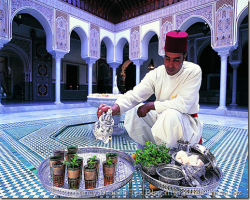Moroccan Mint Tea Traditions, The Secret Ingredients, Tips & Recipe
Morocco’s tradition of tea dates back to the 12th century BC. There are various theories on the origin of tea in the Maghreb. Some say the Berbers (Amazigh) imported tea from Asia, while others believe that Queen Anne Stuart of Great Britain introduced tea to the Moroccan Sultan as a…





